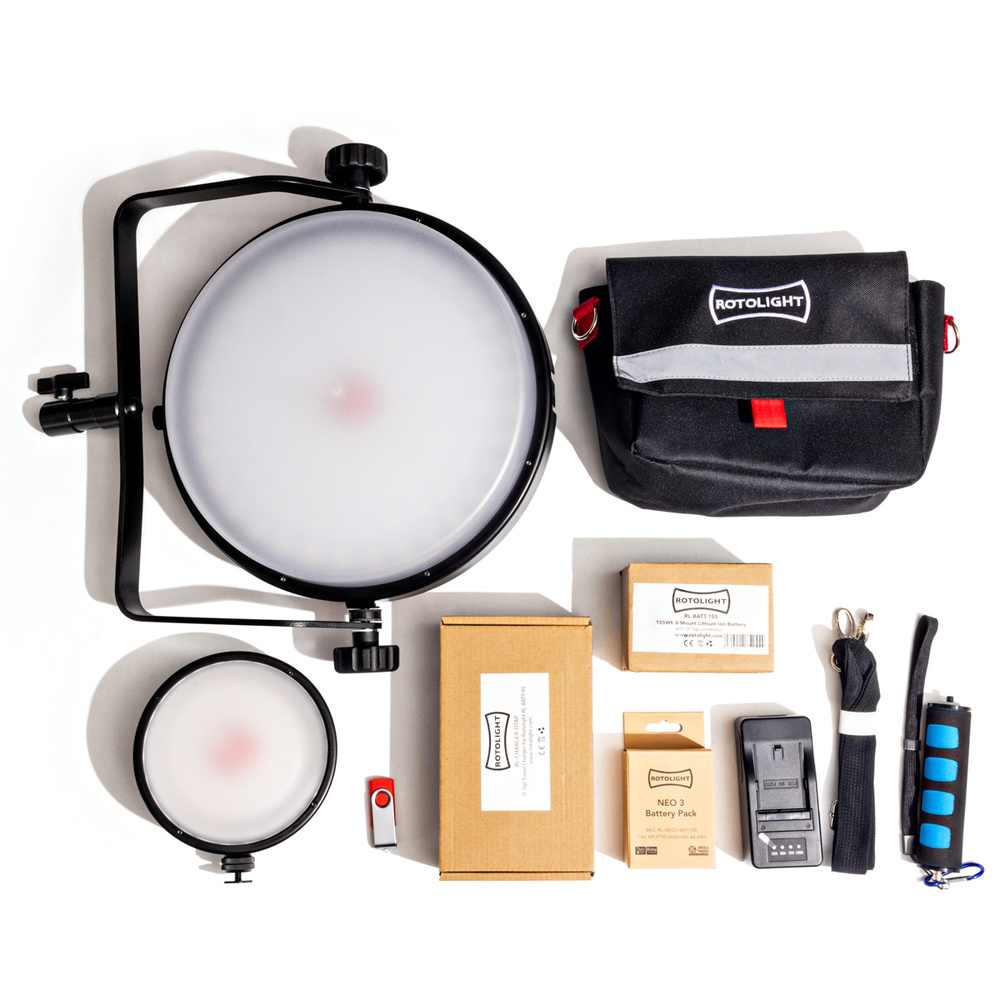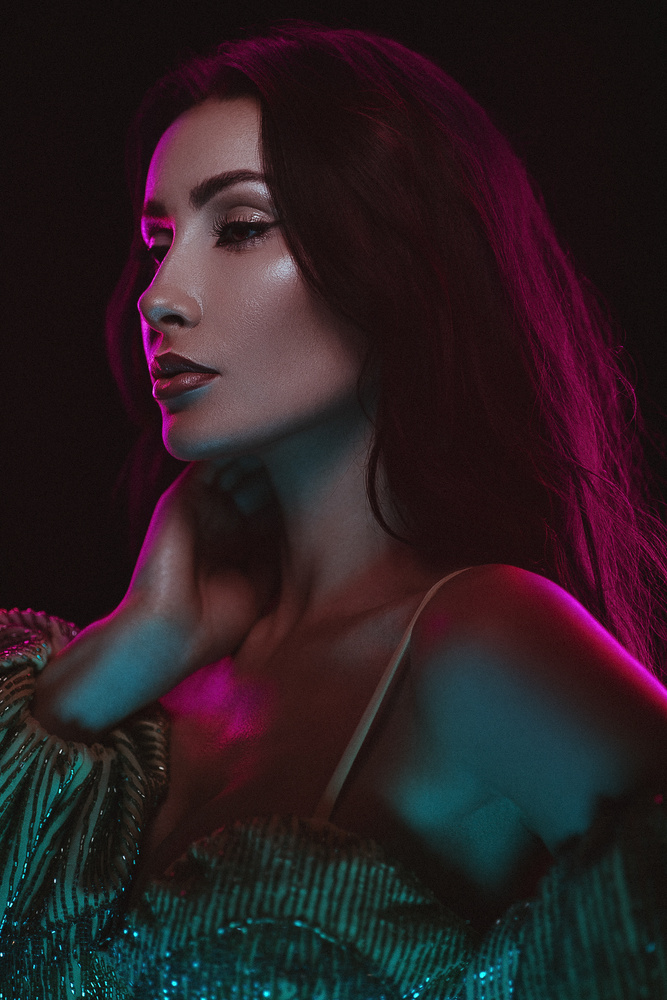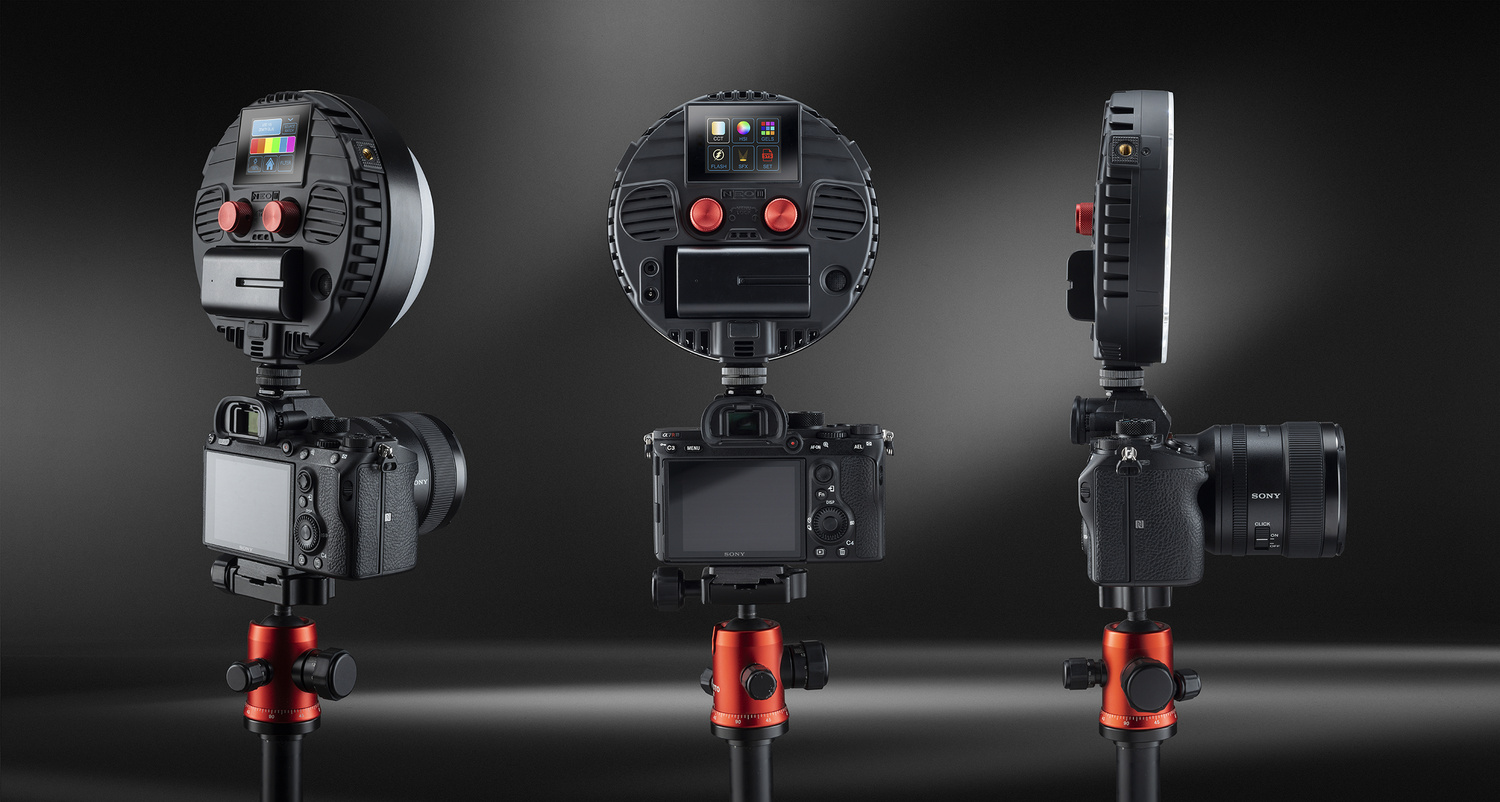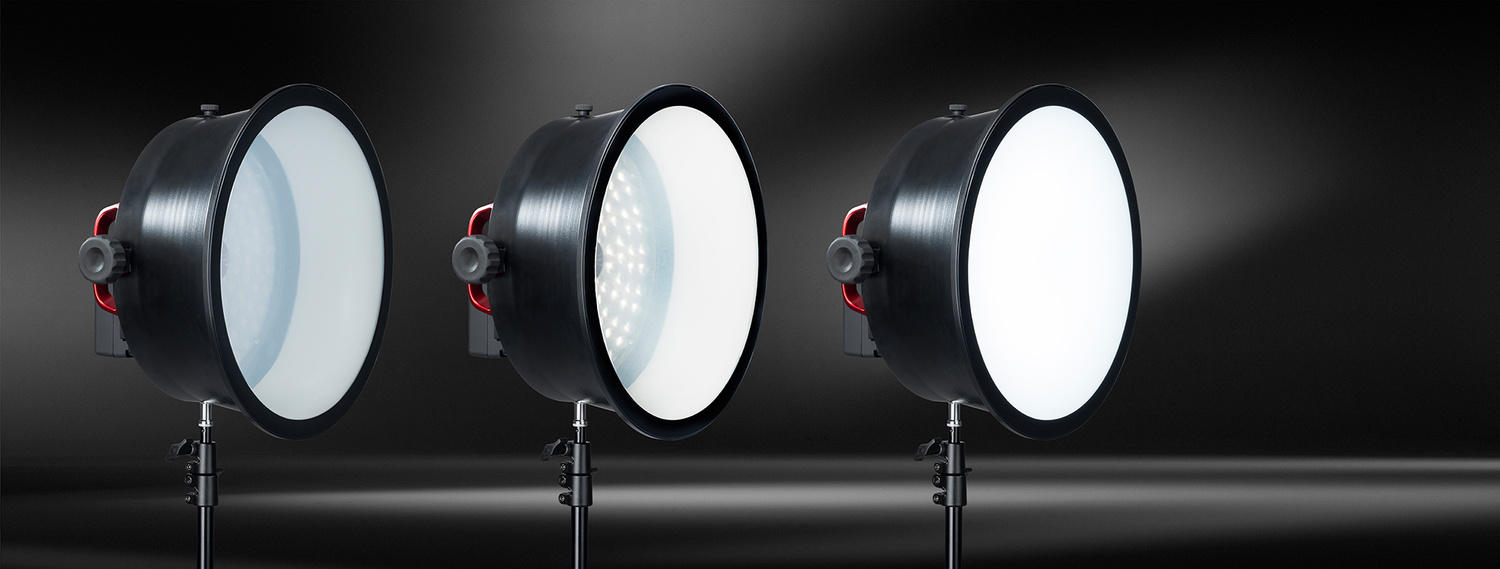When the Rotolight package was delivered to my doorstep, I was apprehensively excited. I was apprehensive because light is everything in photography, and LED lights are notorious for disappointing me. But I was not disappointed. To say I had to rip myself away from playing with it in the studio to type up my review would not be an exaggeration. This light is prodigious.
Let’s start from the outside and move our way in to talk about the PRO AEOS 2 and PRO NEO 3. Although the press material didn’t talk about the bag, the bag is particularly important. Many of us photographers travel and shoot under a myriad of conditions, and if the bag isn’t protecting what is inside, that is a big oversight for me. I executed my first test: I poured a cup of water on it and left it for a few minutes while I made coffee.

Inside the AEOS 2, image Michelle VanTine Photography
When I came back, I was surprised to find the puddle of water still sitting on top of the bag. I opened the bag to see if it had seeped through, and inside was thoroughly dry. It passed the water-resistance test with flying colors.

Rotolight bag passes the water test
The bag as a whole was extremely well-made: water-resistant, sturdy zippers, three large external and one internal pocket, thick padding, and a sleek black look. A+.

Carrier Bag for the Rotolight NEO 3 and AEOS 2, image by Michelle VanTine Photography
Now, to the good stuff: the lights.

I started by setting up the larger one: the PRO AEOS 2. I pressed the power button, and instantly, my studio was saturated with light. The output was impressive. The touchscreen display offered five operating modes, and it was intuitive to navigate.

The back panel of the AEOS 2, image by Michelle VanTine Photography
The CCT (Continuous Light mode) has a touch-screen slider that allows you to vary the temperature from Kelvin 3,000 to 10,000 K with the slide of a finger. Two of the modes: HSI (Hue, Saturation, Intensity), and GELS offer 16.7 million RGB color and GELS for 2,500 digital filters. If that sounded too technical, let me simplify: you can literally put out any color you want. My biggest surprise was the smaller light: the PRO NEO 3. After setting up the PRO AEOS2 as my main light, I positioned the PRO NEO3 as my cross light and flipped the switch on. Woah, the light output! That compact light packs a punch, and it's loaded with all the operating modes as the PRO AEOS 2.

My lighting setup to test out the NEO3 and AEOS 2 for product photography
The reason I have often steered towards using strobes over continuous light in the past is that continuous light output is not strong enough to support shutter speeds fast enough to stop motion without pushing the ISO. If an LED panel is strong enough, the lights are usually blinding and put out heat that I don’t care to work with for hours on end. This light was easy on the eyes with the diffusion on it and also put out very little heat. I gave the lights a test run in studio. Leaving my ISO at a max of 500 and my aperture at f/7.1 for depth of field detail, I was able to stop the motion and create some beautiful splash shots making use of the GEL functions.

Test shots using continuous light and the GELS feature by Michelle VanTine Photography

Test shots using continuous light and the GELS feature by Michelle VanTine Photography
Another test I wanted to run was on the flexibility of the panels to create hard and soft light. Clients or creative directors often have specific looks with shadows. Hard, crisp shadows are the new modern trend, and I was curious if I could create a hard shadow by removing the diffusion on the light.

Diffusion testing: on the left, I created a soft look with a diffused shadow. With the diffusion cover removed, I created harder, crisper, and more defined shadows by removing the diffusion cover. Images by Michelle VanTine
The VFX menu is sure to be the videographer’s favorite. With effects including strobe, fade, party, paparazzi, film, cycle, fire, gunshot, flame, cycle, and more, these pre-programmed lighting effects will provide high-quality scenarios for enhancing feature films or music videos. Rotolight paired up with award-winning visual effects designer Stefan Lange (James Bond Skyfall, Batman, Tombraider) to create these realistic lighting effects.

Image courtesy of Rotolight
Rotolight delivered another industry-first by designing a built-in high-speed sync flash compatible with Godox and Elinchrom flash receivers. This development allows photographers to wirelessly integrate Rotolight into existing systems by utilizing transmitters they already own. With this new technology, you can use your Godox/Elinchrom transmitter to fire off the light like a strobe. There's no need to spend more money on a separate transmitter.
The fifth menu panel: System Settings allows you, among other things, to set up a connection between your LED panel and the Rotolight app. The app easily allows users to control the lights from their phone.

You can use the app to easily adjust the output, color, or effects of the lights.
Who Is This Light For?
As I shot and explored the different settings, I could easily imagine a wide range of usage across the industry. Here are a few.
Portrait Photographers
A quick scroll through Rotolight's Instagram feed shows this light's popularity with photographers who work in portraiture. Renowned portrait artist and educator Jake Hicks created this image using the lights.

Image by Jake Hicks using the NEO3 and AEOS 2, courtesy of Rotolight
Wedding and Event Photographers and Videographers
The lightweight design and portability of the lights make them ideal for event work. Whether shooting weddings, bar mitzvahs, nightlight life, or anything on the go, the lights are easy to carry, set up, and control. The PRO NEO3 can attach to the camera, providing light as professionals move around.

The NEO 3 mounted to a camera
Videographers
Videographers may be the most obvious benefactors of the upgrade to the already-successful PRO NEO and PRO AEOS lights. With a few nearly effortless steps, a professional setup can be designed with custom colors and pre-designed effects.
Content Creators
With businesses from skincare to food and beverage feeling pressed to churn out high-quality content weekly, creators have become an in-demand branch of the industry. Creators can use these lights to easily elevate the look of their photos, videos, and stop-motions without the space requirements or hassle of setting up strobes with modifiers.

Image courtesy of Rotolight
Closing Thoughts
I won't pressure you with closing statements of "this is the new must-have..." Is this the right light for you? It may be. You would know better than I would. The big appeal for me was the output power and versatility of the lights, while still remaining portable and compact. Retailing at $1,999 for the PRO AEOS 2 and $749 for the PRO NEO 3, they are not likely to be an impulse buy. As a professional photographer, I tend to invest in new gear when it does one of two things: if it makes my work significantly better or if it makes my job substantially easier. If you range on the spectrum of hobbyist to amateur, this could be the all-in-one upgrade you've been looking for to create a more professional look to your imagery. If you're a more established photographer that finds themselves wearily trucking a huge cart of gear to every shoot, this could be the one-stop swap to alleviate your load. Overall, for the continuous light category, I give the PRO AEOS 2 and the PRO NEO 3 an earnest A+. What are your impressions? Is this a piece you could see yourself adding to your setup? Leave your thoughts in the comments below.







We've had the previous versions of both the Aeos and the Neo and decided to upgrade to these new versions earlier this year. Both models are a big improvement over the old versions. Much more power, better interface and more robust. While mostly used by our videographers, I occasionally use them for onsite fashion and beauty portraits.
The flash option is useful for stills photographers as it overcomes the potential lack of power in bright settings. The limited choice of modifiers is something that cripples most LED panels, and I don't think they're a substitute for a large studio set-up using strobes (stills only of course). But in smaller settings they're definitely one of the best continuous light options. What I esp. love about these is their round shape. It produces very natural looking catchlights, unlike the common rectangular LED panels.
Oh that's great feedback about the round shape. I used it for the 2nd time today in my studio working on a vegan haircare line. I used one with a bounce card and I was surprised once again at how the light wrapped so nicely. My strobes were in the car from my last job, and it was raining which made me not want to get them. I decided to fire a Rotolight up and give it a shot. It was great. I can imagine this being a great upgrade for still photographers that are intimidated by strobes but are ready for the next step up in their image quality. Thanks for commenting and I'm glad you liked it.
I've never understood the appeal of these things to anyone besides paid YouTube influencers and reviewers. It's like selling a car that also doubles as a bike. Realistically at best it's only going to do one of those jobs well, worst case it does them both poorly. And these things costs as much as a decent portable strobe and an LED panel.
I agree with you. I have a pro photographer friend who is crazy about them. He is always looking for the easy way to get things done. Doesn't even use Photoshop as its really too complicated for him despite being full time for over a decade. I will say that they are really convenient for what they do and if you have this type of money available to spend for that convenience, they are great for what they do. But in the end, these are all just tools that perform well in certain areas. I personally just use a range of strobes/flashes/led wands/led panels and two RGB LED bowens mount lights. All of them are the best tools in certain situations. With the cameras today getting such great ISO performance, there is also a degree of latitude you have with RGB color work.
When you do a lot of product photography, these can be a true timesaver. It's very easy to setup the lights and the built-in colors are easier to apply than having a bunch of gel filters. Besides for videography, we use the Rotolights for shooting perfume bottles and in tight spaces to get some graded fill-in light inside a car interior or so...
Alex Herbert and Sterling Steves I completely understand your perspective. I'm a strobe girl ALL THE WAY. I always use 2 and often 3. They're just so precise, strong etc. As I said in the intro, I'm was hesitant to review bc I'm always disappointed with LED lights. They just don't give me the precision I want. I like control even down to the hardness or softness of my shadows. I've been using it for about 3 weeks now and I'm sincerely (this was NOT a sponsored post) appreciative of having them. I really liked using them for the product shots with gels. WOW. So much easier. And if you look at the "cold beverage" shot I took with it, I don't think it's "well or poor" at all. Also, one of my food client did a massive remodel, I was working with long exposures and Auto-Braketing. The 2 lights were perfect for tucking in a corner and lighting things in the back. Finally, I used it this past week (you can see on my IG @michellevantinephotography) on a stop motion piece. I had the shampoo in a fish tank and I used an air gun to explode it with bubbles. With the continuous light I hold the shutter down for 1 or two seconds and get like 30 frames which I will stitch together for a stop motion. Am I saying that I like it better than strobes? No. Am I saying I'm discovering some scenarios that it's the perfect tool- 100% yes. It all depends on what you shoot. It may not be the right tool for you, but I agree with Jacob H. it's the right tool for so many shots
Completely agree. Yes, they're not the substitute for strobes but a welcome addition for certain types of shoots.
I won’t buy another ROTOLIGHT until they exceed my needs in every department. Just like good strobes do -and have- for years.
Every iteration produces a light that is “better”. Read, “more expensive”. These lights leave a very mottled look on skin that always requires some smoothing in post.
The recommended super expensive rechargeable batteries and charger for Neo suck- they don’t charge well and expire quickly. My fancy charger had to get replaced. ROTOLIGHT was good in that department.
Sadly, but logically, you’ll never get good money out of reselling these lights- we bought the top end model which was discontinued soon after it was released and decided almost immediately the shortcomings vastly outdistanced the claimed benefits, so put them on eBay and realized a vapor echo and smell of cash burning. Bought for $2K each and got $200 for them a year later.
I kinda fell for the set of film effects- they are cute but are a waste for any still photographer- why not make 2 models, “film effects” and a “still photographer” version?
The modifiers are wildly expensive and don’t do much. The round barn doors can’t collapse enough and the silly soft box solely reduced the already too dim light.
When these lights get to “better than required”, I may be back for another look. But based on incremental increase in cost with every new generation, I’m betting I’m gonna rather buy my Ferrari.